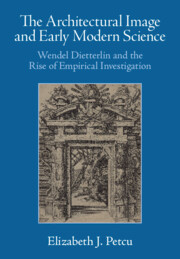 The Architectural Image and Early Modern Science
The Architectural Image and Early Modern Science Published online by Cambridge University Press: 29 November 2024
If Dietterlin’s Architectura epitomized the empirical turn in architectural image-making, the preparatory drawings for the treatise’s etchings show how such firsthand research in art, architecture, and science coalesced in drawing as a context for managing visual research. The 164 surviving Architectura drawings constitute an ideal case study for this phenomenon, for they stand as one of the largest corpora of sixteenth-century architectural drawings made north of the Alps. Dietterlin’s Architectura drawings are compared with drawings from Bramante and Raphael’s St. Peter’s workshop as well as botanical and geological drawings by natural historians Conrad Gessner, Ulisse Aldrovandi, and other natural philosophers. The comparison reveals that, during the sixteenth century, tactics for making images and managing information – such as cutting, collaging, annotation, folding and counterproofing – came to inform both architectural and scientific drawing. Indeed, artists, architects, printers, and natural philosophers began to trade tactics of drawing as a means for managing visual information, thereby codeveloping empirical artistic techniques for producing knowledge. Through its drawings, Dietterlin’s Architectura promoted the new, empirical methodology of architectural image-making.
To save this book to your Kindle, first ensure [email protected] is added to your Approved Personal Document E-mail List under your Personal Document Settings on the Manage Your Content and Devices page of your Amazon account. Then enter the ‘name’ part of your Kindle email address below. Find out more about saving to your Kindle.
Note you can select to save to either the @free.kindle.com or @kindle.com variations. ‘@free.kindle.com’ emails are free but can only be saved to your device when it is connected to wi-fi. ‘@kindle.com’ emails can be delivered even when you are not connected to wi-fi, but note that service fees apply.
Find out more about the Kindle Personal Document Service.
To save content items to your account, please confirm that you agree to abide by our usage policies. If this is the first time you use this feature, you will be asked to authorise Cambridge Core to connect with your account. Find out more about saving content to Dropbox.
To save content items to your account, please confirm that you agree to abide by our usage policies. If this is the first time you use this feature, you will be asked to authorise Cambridge Core to connect with your account. Find out more about saving content to Google Drive.